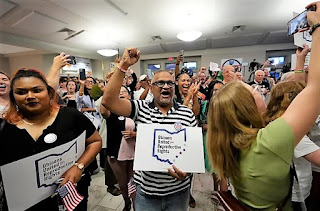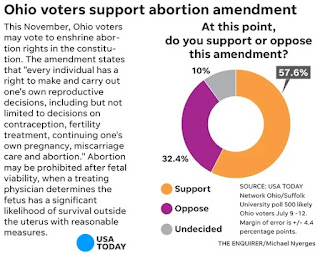The August 8 special election in Ohio produced a convincing victory for the opponents of Issue 1. If it had passed, Issue 1 would have increased the size of the majority necessary to amend the Ohio Constitution from the current 50% + 1 vote majority to a 60% majority. In view of the steeper requirements of most other states, and the two-thirds majority necessary to amend our U.S. Constitution, the call for a 60% majority was certainly reasonable.
In addition to increasing the majority to 60%, Issue 1 would have required that any initiated petition to amend the Ohio Constitution after January 1, 2024 must contain the signatures of at least 5% of the population in each Ohio county. In this way, Issue 1 had aimed to ensure that all counties in Ohio, not just urban counties, can have a voice in the democratic process. [Read more, click HERE.]
Were Ohio Voters Confused?
Admittedly, many of us were disappointed that Issue 1 failed by a wide margin, 57% to 43%. Our first reaction was to believe that the vote did not reflect the values that a majority of Ohioans place on the sanctity of the life of unborn children, and of their mothers and fathers. After all, both opponents and supporters focused their appeals on protecting the Ohio Constitution and suggested that, if we don’t vote their way, the will of Ohioans will cease to be represented. Because abortion was highlighted less by both sides, we thought the outcome might represent a confused electorate rather than their views on abortion.
However, when we looked at the polling data prior to the election, we discovered that the “confused voter theory” would not hold water. Opinion polls taken prior to August 8 revealed that a majority of Ohioans had already declared their opposition to the Heartbeat Law. In fact, a USA TODAY Network/Suffolk University poll (Click HERE.), conducted July 9-12, 2023 with a margin of error of + 4.4%, indicated that 58% of Ohio voters supported the abortion rights proposal that may be on the November, 2023 ballot, 32% opposed it, and 10% were undecided. As noted earlier, an almost identical 57% of Ohioans voted against Issue 1. Also, and Emerson College Poll (Click HERE.) conducted in October, 2022 registered a similar result with 54% opposed, 46% in support of the Heartbeat Law.
We might conclude that the defeat of Issue 1 was in fact reflective of Ohioan’s position on abortion law and not due to confusion from the campaign arguments. But wait! We ought to address three more questions that arise--one from the polling data, another from the distribution of the voting across the State of Ohio, and the third, “How Should We Respond?”
Are Polling Data Accurate?
The accuracy of any polling data depends upon how the sampling of public opinion was collected. For example, how were the questions worded, how large was the sample size, and was the sampling representative, in this case, of the voting population of Ohio? In our opinion, the USA TODAY Network/Suffolk University poll does not meet these standards. The polling sample size was only 500 Ohio voters. This number amounts to only one-half dozen voters per county, and it is unlikely that every Ohio county was represented. Of the 500 voters questioned, only 46 people were registered voters! So, the conclusions made from this poll was based largely on 454 individuals, many of whom may not have cared enough to invest the time to become informed and then actually vote.
Nevertheless, we might be tempted to accept the polling results based on the fact that, as we noted above, its results predicted very closely how the vote on Issue 1 would fall. On the surface, this logic appears sound. However, we must remember that while pre-election polls can predict the outcome, there is also the possibility that polls can influence an outcome. For example, voters who have a weak moral foundation and/or who are easily swayed by the direction of the crowd or culture could be influenced by polling data favorable toward abortion.
We now turn to our third question: Was the outcome of the special election representative of the opinion of Ohioans as a whole? Just as polling data can fail to represent the opinion of a population at-large; so, a political issue can be decided without a large sector of the population being represented. Let’s look at the distribution of the August 8 voter returns.
Did the Vote Represent All of Ohio?
Results of the election in each county suggest that the wishes of the rural population of Ohioans, spread over much of the area of the state and representing 67 counties, were not represented in the outcome. Instead, the outcome was determined largely by urban voters in only 21 counties out of 88 Ohio counties. Granted, Issue 1 failed on the basis of vote count. But it is unfortunate that high population densities in relatively few Ohio cities can overpower the wishes of voters in hundreds of small cities, towns, and rural areas.
Perhaps there are at least two challenges given by the defeat of Issue 1. First, the defeat is an example of the will of “urban Ohio culture” being exercised over the will of “rural Ohio culture.” This outcome emphasizes all the more the importance of the requirement stated within Issue 1. Namely, if both cultures in Ohio are to be represented in major lawmaking decisions, then any constitutional amendment should require supporting signatures from all Ohio counties. Second Ohio will become further divided politically, culturally, and spiritually, unless we work to improve communication and understanding between urban and rural cultures. If we do not, Ohio will join other states like Illinois, Michigan, and California where cultural values of the more conservative rural landscape are held hostage by deteriorating urban areas.
How can we accomplish bridging the “two Ohio’s?” From a Christian viewpoint, we have many examples of how the church has been effective in bringing people out of hopelessness to salvation and restoration. Throughout history and around the world, God’s people have given their love, treasures, and message of hope to urban dwellers. Many urbanites have never traveled to a rural landscape or been exposed to rural culture and values. Perhaps readers will join us in praying, seeking God’s leading on how to respond to this need which is increasing with the increase in urban lawlessness and the influx of migrants. For example, we just published an article, “Community Caring for People and Land” (CLICK HERE.) What if the example of community caring for people and land exercised in small town Ohio through parks and recreation organizations, churches, etc. could be expanded to build bridges into larger urban communities? Please let us hear from you. Use “Comments” below or contact us at silviusj@gmail.com.
How Should We Respond?
No one likes to lose, especially in an important election. But we must press on realizing that the Heartbeat Law may be on the ballot in November. We can be informed, advocate, and pray on behalf of lives of the unborn. We can continue to use the 6-Week Prayer Guide for Ohio, the Unborn, and Women entitled More Than Conquerers, which is freely available for individuals, churches, or groups from the Center for Christian Virtue, an Ohio advocacy group (CLICK HERE for more information.).
Prayer reminds us that we serve on behalf of God’s purposes and His coming kingdom. Prayer helps us develop a distinct hate and aversion to sin while loving the sinner as Christ loves all of us sinners, both the redeemed and those who still need to repent and receive Christ as their Savior.
Again, our readers should understand that we do not condemn mothers who elect to have an abortion, or the fathers who support or press for that decision. Rather, we condemn the act of abortion and regret the sin and the judgment that follows this violation of God’s command not to murder (Genesis 9: 6: Exodus 20: 13). Isn’t it tragic when mothers who are alive because their mothers chose life decide that their babies have no right to live? Even apart from the penalty of violating God’s law are the natural consequences of violating the “sowing and reaping principle (Galatians 6: 7-8)”:
Do not be deceived: God is not to be mocked.
Whatever a man sows, he will reap in return.
The one who sows to please his flesh,
from the flesh will reap destruction;
but the one who sows to please the Spirit,
from the Spirit will reap eternal life.
We conclude with a challenging call from the six-week prayer booklet, More Than Conquerers, cited above. The call is to worship and lift our prayers to God on behalf of the unborn, mothers, and fathers:
“American culture is captivated by instant gratification. As our attention spans have waned, so has our ability to wait; to endure moments of discomfort and distress; even to understand why sometimes we shouldn't get everything we want the moment we want it.
In such a culture, patient and persistent prayer to the God of the universe is a radical idea. Prayer is stillness. Prayer takes time. Prayer requires honesty and, even sometimes, discomfort. Prayer acknowledges that we are not in control.
Through prayer, Christians are invited to "humble yourselves under the mighty hand of God so that at the proper time He may exalt you, casting all your anxieties on Him, because He cares for you" (1Peter 5: 7).
Not only is prayer counter-cultural to those outside the church; often it's misunderstood inside. Prayer is not a moment that we decide to spend in God's presence, as if He lives in our world. Rather, prayer is a moment in which we discipline our hearts to focus on God's constant presence.
Through prayer, we worship God. Through that worship, we tune our hearts to His goodness. We remind ourselves of who He is, and of the gift of knowing and trusting Him. And yes, we bring Him our supplications-- because that is what Jesus told us to do when He said to pray for His Kingdom to come and His will to be done (Matthew 6: 10).
Praying for the protection of preborn babies in a culture captivated by instant gratification, the worship of "individualism," and a growing disdain for the value of human life can feel like a futile endeavor. But let us remember, again, how God delivered His people from slavery in Egypt. Exodus 3 contains five of the most radical words in all of Scripture: "I have heard their cries." And because God heard those cries, with a "mighty hand and an outstretched arm (Deuteronomy 26: 8), He brought justice.
Pray this week, with confidence in God's goodness and His deliverance, that He would hear the cries of His people for the protection of new life. Pray that He would turn the hearts of mothers toward their children and away from fear, and that He would thwart all plans of the Enemy to persist in building a culture of death. Pray that his justice would "roll down like waters" (Amos 5: 24). Pray that his Kingdom would come, where every human life no matter how new or small or "planned," is valued and protected. Pray that his will would be done. (From: More Than Conquerers, Center for Christian Virtue, pages 13-14.)
Comments:
As always, we welcome “Comment” from readers. We are particularly interested in your thoughts about the “two Ohio’s,” one urban and the other rural as the Ohio map of Issue 1 voting clearly shows. If you reside in another state, or in a smaller town or city, you may still experience this two-culture phenomenon. How can we make a difference? Please use the “Comment” link below for ideas or questions; or, contact us personally at silviusj@gmail.com






















